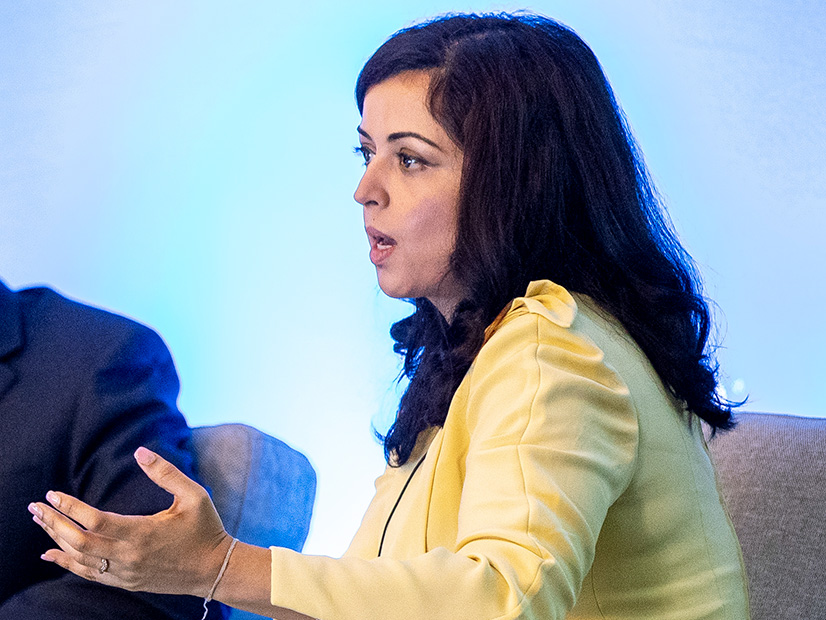
BALTIMORE — Panelists during the General Session at PJM’s Annual Meeting last week focused on the evolving security and climate risks the electric industry faces, as well as the potential for technology and a culture of creativity to provide new solutions.
Delivering the keynote speech, Elisabeth Braw, senior fellow at the Atlantic Council’s Scowcroft Center for Strategy and Security, said hostile geopolitics are clashing with a globalized economy, putting companies across the world at risk of being caught in the crossfire.
Because cybersecurity threats are global and often have more to do with national policies than the actual targets, she said individualized efforts at preparation can go only so far. Instead, she recommended organizations work together to identify vulnerabilities and share strategies.
That coordination often should include the public as well: One mistake Braw said many working in critical infrastructure make is being too tight lipped about the risks they face and their mitigation efforts. She pointed to the cyberattack that interrupted Colonial Pipeline operations in 2021, saying the impacts of the attacks were manageable but that an underinformed public began panic-buying gas and compounding constraints on the pipeline.
Braw was joined on a panel about the intersection of risk management with national and world events by NERC Vice President Manny Cancel and Paul Williams, president of the Electric Infrastructure Security (EIS) Council. The panel was moderated by PJM Chief Risk Officer Carl Coscia.
Cancel said joining a regional information sharing and analysis center (ISAC) can allow smaller organizations, such as municipal electric providers, to develop the broad expertise and awareness that large utilities often hold.
Williams said resilience is possible only through working with the communities an organization is part of. Understanding which services are most important to customers, and which business functions are needed to maintain those services, is key. As the former head of the Bank of England’s Operational Risk and Resilience Division, he said ATMs may seem like a core need, but what truly is important to users is access to cash — an understanding that creates opportunities for building resilience even if ATM networks are disrupted.
Turning to climate risks, Cancel said the largest challenges are the siting, permitting and interconnecting of new generation and harmonizing the clean energy transition with reliability needs.
Maintaining the infrastructure the grid requires now and throughout the transition will require honest conversations with the public about what the costs will be, Williams said.
Innovation Potential and Challenges
Another panel on applied innovation largely focused on the double-edged sword of the rising capabilities of artificial intelligence.
Jonathan Glass, acting deputy director for commercialization at the U.S. Department of Energy’s Advanced Research Projects Agency — Energy (ARPA-E), said AI could speed research into new storage and generation technologies — as well as improve the process for interconnecting them — but the electric industry first will need to get over the hump of rapidly increasing load growth over the next few years as data centers come online.
Arshad Mansoor, CEO of the Electric Power Research Institute (EPRI), said AI development is in the “first mile of a marathon” that could see unprecedented load growth over the next few years, potential business that could flow to other nations if the electric sector cannot keep up. He said the next three to four years will be the most important in laying that groundwork, which will have to involve expanding load flexibility while new generation and transmission are built.
“The country, the region that can power this infrastructure will win the AI race,” he said.
Mansoor said there’s a disconnect between the personnel working in the electric industry and on the data center side and that more understanding between the two is needed. Forecasting data center demand is changing constantly as computational needs increase and breakthroughs are made in the efficiency of hardware.
Consumer behavior also could be part of the solution, said Arushi Sharma Frank, principal of Luminary Strategies, such as creating virtual power plants using electric vehicle batteries, home storage systems and smart meters to reduce load during peak periods and shift it to more economical times.
Perfecting such technologies will require creative thinking and data analytics skills, Frank said, a pairing that is in demand across industries. Loosening regulations around hiring and immigration could allow individuals working overseas to contribute.


